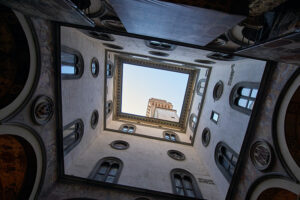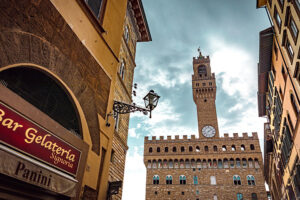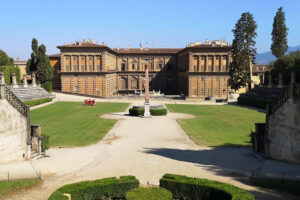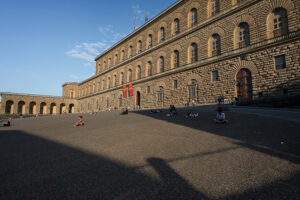Ponte Vecchio bridge: history of an amazing landmark
Walking along the banks of the Arno river, and over the bridges that run across it, is one of my favorite things to do in Florence. The shimmering river water, the light that shines onto the palaces that line the river banks, the views of the hills in the distance, and the colors of the sky above are never quite the same.
Naturally, a lot depends on what bridge you’ve chosen for your daily walk: each of Florence’s ponti (Italian for bridges) offers a different and unique viewpoint.
This said, there is one bridge that “beats” all others in terms of fascination, and that’s the Ponte Vecchio bridge
Why is it called Ponte Vecchio?
Ponte Vecchio literally translates as “old bridge” and is the name given to this bridge starting in 1220, when Florence’s second bridge was built. The latter was called Ponte Nuovo, i.e. “new bridge” and the former thus became Ponte Vecchio, “old bridge”.
History of the Ponte Vecchio
The history of the Ponte Vecchio covers over 670 years and is filled with thrilling stories and events. The bridge we see today was built in 1345, but historical records show that a wooden footbridge called “Ponte Sulpicio” existed, and rose in the exact spot, which was and is the narrowest stretch over the river, ever since the ancient Roman era.
On November 4, 1177, a flood carried the wooden bridge off. The Florentines quickly rebuilt it using five stone arches along with the basic wooden parts. It was barely half as wide as the present one (a little over 0.580 meters across), and walking space was even narrower because there were 43 stores flanking the sides. During the 1200s, Florence’s population increased, and commercial activity flourished. Needless to say, the city needed a wider, more “comfortable” bridge to favor connections between the two opposite sides of the river. Starting in 1220 more bridges were built: the first “new bridge” is the one we know as Ponte alla Carraia, the second the Ponte alle Grazie, and the third the Ponte a Santa Trinita.
Ponte Vecchio in the 13th century: businesses and floods
As the number of Florence’s bridges grew, so did the Ponte Vecchio’s, the old bridge’s, very own “economy”. More shops were built to host butchers (called “beccai”), fishmongers, fruit and vegetable stores, and “borsai”, stockbrokers, and their businesses prospered. But, alas, both the Ponte Vecchio and the shops on it were regularly, and severely, damaged by recurrent floods. On November 4, 1333, all 4 of Florence’s bridges toppled down into the Arno.
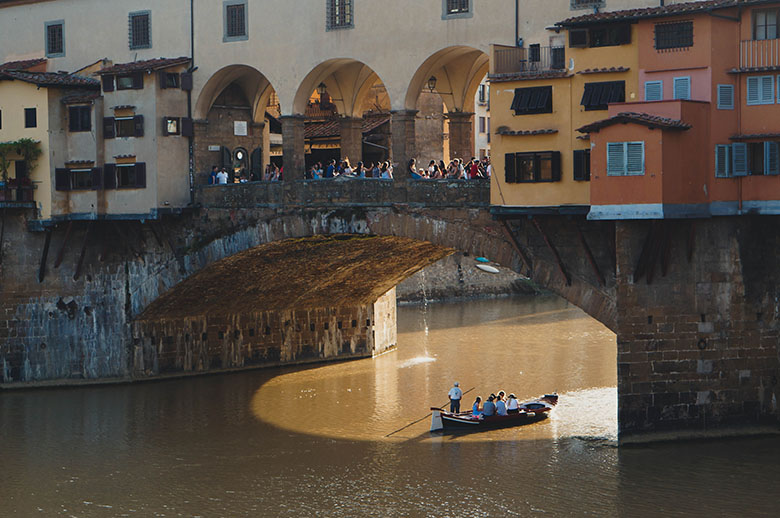
Taddeo Gaddi’s wonderful new “old bridge”
Luckily, the arts and architecture were also flourishing: Florence’s Renaissance had begun, and great masters and geniuses were working on the city’s palaces, churches, houses, and squares. And so it was that Taddeo Gaddi, a pupil of the great Giotto, presented a plan to build a “new Ponte Vecchio”: it was to be the very first segmental arch bridge in the Western world. By using five arches instead of three, lowering them (to add space between the piers without bending the road surface), and placing them on just two slender piers, Gaddi “lightened” the bridge’s overall bulk, making it resilient to floods.
The buildings on top of Ponte Vecchio
Today, the evocative golden-yellow and cream-colored buildings that rise on the Ponte Vecchio house glitzy jeweler shops on the ground floor and the famed Vasari Corridor on the top. These features are what make Ponte Vecchio the most famous bridge in Italy… but it’s not exactly the way it used to be.
The Grand Duke, the butchers, and the jewelers
Before the Vasari Corridor was built in 1565, to serve as a safe and private passageway that the Medici lords, rulers of Florence, could use to get from their residence in the Pitti Palace to their “offices” in the Uffizi and Palazzo Vecchio, the Ponte Vecchio bridge was a veritable open-air market, and butchers had their stalls on the bridge too. Once the aerial corridor was built the Grand Duke, Ferdinando I Medici, decided he’d rather have something more elegant, and less “smelly”, below his personal walkway. And so, on September 25th, 1593, he ordered all the “dirty” businesses away and had them replaced by goldsmiths, silversmiths, and jewelers!


